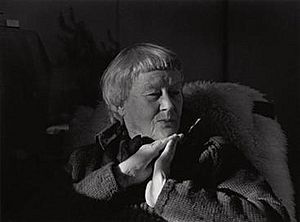Priaulx Rainier facts for kids
Ivy Priaulx Rainier (born February 3, 1903 – died October 10, 1986) was a composer from South Africa and Britain. Even though she lived most of her life in England and passed away in France, her music was greatly inspired by the African music she remembered from her childhood. She didn't use a popular style called "12-tone music," but she understood it well. She was one of the first composers in England to write music without a main melody or theme. Famous cellist Jacqueline du Pré performed her Cello Concerto in 1964. Later, the well-known violinist Yehudi Menuhin played her Violin Concerto Due Canti e Finale in 1977.
Contents
A Young Musician's Life
Priaulx Rainier was born in 1903 in Howick, Colony of Natal (which is now part of South Africa). Her father was from a French Protestant family called Huguenots, and her mother was English. One of her sisters played the cello.
When Priaulx was 10, her family moved to Cape Town. There, she started learning the violin at the South African College of Music. At 17, in 1920, she moved to London for good. She won a scholarship to study at the Royal Academy of Music (RAM). She learned from teachers like Rowsby Woof and Sir John Blackwood McEwen.
After her studies, she taught violin at Badminton School in Bristol. She also played violin in a string quartet, which is a group of four string instruments. The famous composer Arnold Bax encouraged her to compose. In 1937, she studied briefly with Nadia Boulanger in Paris. However, Priaulx Rainier mostly considered herself a self-taught composer.
Starting to Compose
Priaulx Rainier began composing in 1924. But she didn't write much until 1937, after she recovered from a serious car accident in 1935. Her first recognized piece was Three Greek Epigrams for voice and piano.
Her first important work was the String Quartet No. 1 in C minor, written in 1939. It was first played privately in 1940. It became public in 1944 at Wigmore Hall and was recorded by the Amadeus Quartet in 1949. This music was even used for a ballet called Night Spell.
Priaulx Rainier often used short, repeated musical patterns, like a drum beat, in her works. This style can be heard in her Viola Sonata (1946) and the Barbaric Dance Suite for piano (1949). Other pieces from this time include a Suite for clarinet and piano (1943) and a Sinfonia da camera for strings (1947). Her first big work for voices was Orpheus Sonnets.
In 1939, she became a Professor of Composition at the RAM and stayed there until 1961. She helped start the St Ives September Festival in 1953 with her friend, composer Michael Tippett.
Her Amazing Music
Priaulx Rainier wrote many different kinds of music. Her first large piece for an orchestra was Phalaphala (1961). The word "Phalaphala" means an African chief's ceremonial horn. This piece celebrated Sir Adrian Boult's ten years with the London Philharmonic Orchestra.
The famous singer Peter Pears and the Purcell Singers first performed her Requiem (1956). This piece was for a tenor singer and a choir without instruments. It used a poem written for her by David Gascoyne about victims of war. Peter Pears also asked Rainier to write Cycle for Declamation (1954) and The Bee Oracles (1970).
Her oboe quartet Quanta was asked for by William Glock, who was in charge of music at the BBC. The title Quanta comes from quantum theory.
Famous Concertos
The Cello Concerto was written for a Prom Concert in 1964. The amazing cellist Jacqueline du Pré played it for the first time with the BBC Symphony Orchestra. Some say that du Pré found the concerto very challenging to play.
One of Priaulx Rainier's biggest works was the orchestral suite Aequora Lunae. This piece has seven parts, and each one describes one of the "seas" on the Moon. She dedicated it to her friend, the sculptor Barbara Hepworth. Rainier felt that only sculptors and architects truly understood her music.
Another piece, Ploërmel (1973), was performed at a Prom Concert. It was inspired by Ploërmel in France, one of her favorite places. This piece uses an orchestra of wind instruments and many types of percussion, like drums, bells, and gongs.
Her violin concerto, Due Canti e Finale, was asked for by Yehudi Menuhin. He performed it at the Edinburgh Festival in 1977. Menuhin said Rainier had "a musical imagination of a colour and variety scarcely to be believed."
Priaulx Rainier's music was often difficult for both musicians to play and listeners to understand. Because of this, her pieces were not performed very often. However, her complete chamber music was recorded and broadcast by the BBC in 1976.
Later Years and Legacy
In 1982, the University of Cape Town gave Priaulx Rainier an honorary doctorate in music. She loved gardening and protecting nature. She even helped design and plant the special plants in Barbara Hepworth's Sculpture Garden in St Ives. Her last work, Wildlife Celebration, was asked for by Yehudi Menuhin. It was performed to help Gerald Durrell's Wildlife Conservation Trust.
Priaulx Rainier passed away on October 10, 1986, in Besse-en-Chandesse, France, at the age of 83.
Most of her original music papers are now kept at the J. W. Jagger Library at the University of Cape Town.
In 1987, a concert celebrating her life and work was held at Wigmore Hall. A book about her life, Come and Listen to the Stars Singing, was published in 1988.
On her 100th birthday in 2003, Australia's ABC Classic FM had a special program about her. A "lost" early String Quartet she wrote in 1922 was finally performed for the first time in 2004. Also, her Movement for strings, which was almost finished in 1951, was completed by Douglas Young and performed at the BBC Proms in 2013.


